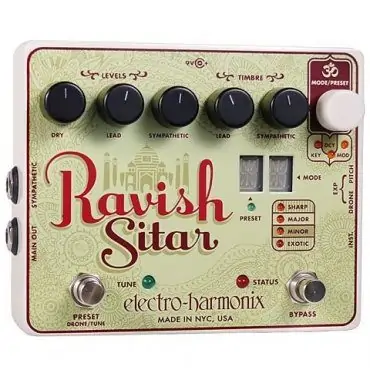
Unless you’ve been living under a rock you have most likely heard the sitar, an Indian instrument which creates a very complex and distinct sound derived by the use of sympathetic strings, a long neck, and gourd chamber.
The Ravish Sitar (whose name is probably a play off of the Godfather of Sitar’s Ravi Shankar) is coming to us from our fine folks at Electro-Harmonix. The task of recreating such a complex and distinct instrument is something I would consider impossible. Others have tried but let’s just say that the prize was still up for grabs, until now. After perusing even the 10 presets I was convinced that if the Sitar was going to be emulated by a guitar pedal, then it’s got to be the Ravish.
This pedal is vastly deep and to get a real handle for the depth I recommend reading the manual a few times over. I did and I am still having to reference it for certain functions. That said, it’s the depth that really makes this instrument so good at what it is. So what is it? To say that it is just a Sitar emulator would be an understatement. It does emulate a Sitar better than anything else but, considering all of the sonic expression under the hood it lends itself to be a bit of a sound designer’s dream come true.
The technology involved may be a secret but allow me to define some of the functions of this beast. You’ve got an instrument input and two outputs. One output is designated for the Main Output which is a mix of sympathetic drone and lead tone. The other is an output dedicated to the sympathetic strings which removes the sympathetic from the main output when in use (very clever). There are two inputs that pertain to the modulation capabilities of the device. The first is for bending the pitch of the lead tone by as much as an octave. The second is for controlling the modulation of the drone. The Preset button also serves the purpose of allowing you to freeze the drone of the sympathetic strings. Knob-wise we have level knobs for the dry, lead and sympathetic tones as well as timbre controls for the lead and sympathetic. Lastly, we’ve got the Mode/Preset knob that allows you to switch between the various modes as well as the presets.
How does all of this stuff work together? The idea is to pick a key and scale and then tweak the level and timbre knobs to taste. To get the most sonically pleasing results pick your key and scale by pressing the Mode/Preset knob until the Key LED is lit then twist the knob to run through the list of keys and scales that include Sharp, Major, Minor and Exotic. The ability to program your own scale and to choose the key based on the note played is also available if you dig a little deeper. Next, you can tweak the decay time of the lead tone which varies from a parameter value of 0 to 9. One more press of the Mode/Preset button will put you in Mod mode which adds a variable rate of modulation to the sympathetic strings which is meant to emulate the sound of a tanpura, an instrument commonly used in live performance to accompany the Sitar. When in any mode other than Key you can press and hold the Preset foot switch to freeze the drone of the sympathetics. Man, they thought of everything.
In use, I had so much fun tweaking the 10 presets that I didn’t dig too deep into the depths of programming the thing. That may have had something to do with the fact that the presets are designed by the folks that made the magic happen and they sound really amazing. Just playing with the timbre knobs can be tons of fun and can welcome many sonic surprises. I used this in conjunction with my electric and it sounded super Sitar-licious. I will be perfectly honest in saying that it didn’t sound like I had a Sitar miked up with a few Neve’s and Neumann’s but it did sound more Sitar-like than I could have imagined. One thing I didn’t have the chance to do is hear an acoustic through it. In scouring the web I was able to find a few examples as well as on E-H’s own website. I must say that it sounded even closer due to the added resonance and organic nature of the instrument. Another thing I didn’t get into was the expression pedal capabilities for pitch bend and drone level for no good reason other than I don’t have an expression pedal. This is another exciting aspect not to be overlooked.
Of course, it wouldn’t be me if I didn’t run some other sound sources through it. I started with my trusty synthesizer. Wow, talk about crazy town! The sympathetics mixed with filter sweeps and sawtooth waves provided some incredibly rich overtones. I ran a drum machine through it and got similar results that one might expect from running a drum machine through a Vocoder but not quite as exciting.
All in all I felt like the Ravish Sitar is definitely best in it’s class by an intimidatingly large margin. While incredibly deep, the folks at E-H managed to put together a feature set that provides just enough functionality to effectively emulate a Sitar with a guitar pedal. A feat that had previously gone unaccomplished. If one is able to look at this pedal as much more than just a Sitar emulator then a sonic reward will certainly be due. Another lovely pedal by a lovely company. -Gus Green






















